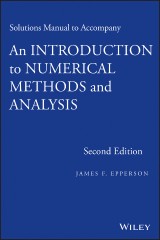Details

An Introduction to Numerical Methods and Analysis, Solutions Manual
2. Aufl.
|
25,99 € |
|
| Verlag: | Wiley |
| Format: | |
| Veröffentl.: | 28.08.2014 |
| ISBN/EAN: | 9781118789384 |
| Sprache: | englisch |
| Anzahl Seiten: | 316 |
DRM-geschütztes eBook, Sie benötigen z.B. Adobe Digital Editions und eine Adobe ID zum Lesen.
Beschreibungen
<p><b>A solutions manual to accompany <i>An Introduction to Numerical Methods and Analysis, Second Edition</i></b></p> <p><i>An Introduction to Numerical Methods and Analysis, Second Edition</i> reflects the latest trends in the field, includes new material and revised exercises, and offers a unique emphasis on applications. The author clearly explains how to both construct and evaluate approximations for accuracy and performance, which are key skills in a variety of fields. A wide range of higher-level methods and solutions, including new topics such as the roots of polynomials, spectral collocation, finite element ideas, and Clenshaw-Curtis quadrature, are presented from an introductory perspective, and the <i>Second Edition</i> also features:</p> <ul> <li>Chapters and sections that begin with basic, elementary material followed by gradual coverage of more advanced material</li> <li>Exercises ranging from simple hand computations to challenging derivations and minor proofs to programming exercises</li> <li>Widespread exposure and utilization of MATLAB</li> <li>An appendix that contains proofs of various theorems and other material</li> </ul>
<p><b>1 Introductory Concepts and Calculus Review 1</b></p> <p>1.1 Basic Tools of Calculus 1</p> <p>1.2 Error, Approximate Equality, and Asymptotic Order Notation 12</p> <p>1.3 A Primer on Computer Arithmetic 15</p> <p>1.4 A Word on Computer Languages and Software 19</p> <p>1.5 Simple Approximations 19</p> <p>1.6 Application: Approximating the Natural Logarithm 22</p> <p>1.7 A Brief History of Computing 25</p> <p><b>2 A Survey of Simple Methods and Tools 27</b></p> <p>2.1 Horner’s Rule and Nested Multiplication 27</p> <p>2.2 Difference Approximations to the Derivative 30</p> <p>2.3 Application: Euler’s Method for Initial Value Problems 40</p> <p>2.4 Linear Interpolation 44</p> <p>2.5 Application— The Trapezoid Rule 48</p> <p>2.6 Solution of Tridiagonal Linear Systems 56</p> <p>2.7 Application: Simple Two-Point Boundary Value Problems 61</p> <p><b>3 Root-Finding 65</b></p> <p>3.1 The Bisection Method 65</p> <p>3.2 Newton’s Method: Derivation and Examples 69</p> <p>3.3 How to Stop Newton’s Method 73</p> <p>3.4 Application: Division Using Newton’s Method 77</p> <p>3.5 The Newton Error Formula 81</p> <p>3.6 Newton’s Method: Theory and Convergence 84</p> <p>3.7 Application: Computation of the Square Root 88</p> <p>3.8 The Secant Method: Derivation and Examples 92</p> <p>3.9 Fixed Point Iteration 96</p> <p>3.10 Roots of Polynomials (Part 1) 99</p> <p>3.11 Special Topics in Root-finding Methods 102</p> <p>3.12 Very High-order Methods and the Efficiency Index 114</p> <p><b>4 Interpolation and Approximation 117</b></p> <p>4.1 Lagrange Interpolation 117</p> <p>4.2 Newton Interpolation and Divided Differences 120</p> <p>4.3 Interpolation Error 132</p> <p>4.4 Application: Muller’s Method and Inverse Quadratic Interpolation 139</p> <p>4.5 Application: More Approximations to the Derivative 141</p> <p>4.6 Hermite Interpolation 142</p> <p>4.7 Piecewise Polynomial Interpolation 145</p> <p>4.8 An Introduction to Splines 149</p> <p>4.9 Application: Solution of Boundary Value Problems 156</p> <p>4.10 Tension Splines 159</p> <p>4.11 Least Squares Concepts in Approximation 160</p> <p>4.12 Advanced Topics in Interpolation Error 166</p> <p><b>5 Numerical Integration 171</b></p> <p>5.1 A Review of the Definite Integral 171</p> <p>5.2 Improving the Trapezoid Rule 173</p> <p>5.3 Simpson’s Rule and Degree of Precision 177</p> <p>5.4 The Midpoint Rule 187</p> <p>5.5 Application: Stirling’s Formula 190</p> <p>5.6 Gaussian Quadrature 192</p> <p>5.7 Extrapolation Methods 199</p> <p>5.8 Special Topics in Numerical Integration 203</p> <p><b>6 Numerical Methods for Ordinary Differential Equations 211</b></p> <p>6.1 The Initial Value Problem — Background 211</p> <p>6.2 Euler’s Method 213</p> <p>6.3 Analysis of Euler’s Method 216</p> <p>6.4 Variants of Euler’s Method 217</p> <p>6.5 Single Step Methods— Runge-Kutta 225</p> <p>6.6 Multistep Methods 228</p> <p>6.7 Stability Issues 234</p> <p>6.8 Application to Systems of Equations 235</p> <p>6.9 Adaptive Solvers 240</p> <p>6.10 Boundary Value Problems 243</p> <p><b>7 Numerical Methods for the Solution of Systems of Equations 247</b></p> <p>7.1 Linear Algebra Review 247</p> <p>7.2 Linear Systems and Gaussian Elimination 248</p> <p>7.3 Operation Counts 254</p> <p>7.4 The LU Factorization 256</p> <p>7.5 Perturbation, Conditioning and Stability 262</p> <p>7.6 SPD Matrices and the Cholesky Decomposition 269</p> <p>7.7 Iterative Methods for Linear Systems – A Brief Survey 271</p> <p>7.8 Nonlinear Systems: Newton’s Method and Related Ideas 273</p> <p>7.9 Application: Numerical Solution of Nonlinear BVP’s 275</p> <p><b>8 Approximate Solution of the Algebraic Eigenvalue Problem 277</b></p> <p>8.1 Eigenvalue Review 277</p> <p>8.2 Reduction to Hessenberg Form 280</p> <p>8.3 Power Methods 281</p> <p>8.4 An Overview of the QR Iteration 284</p> <p>8.5 Application: Roots of Polynomials, II 288</p> <p><b>9 A Survey of Numerical Methods for Partial Differential Equations 289</b></p> <p>9.1 Difference Methods for the Diffusion Equation 289</p> <p>9.2 Finite Element Methods for the Diffusion Equation 293</p> <p>9.3 Difference Methods for Poisson Equations 294</p> <p><b>10 An Introduction to Spectral Methods 299</b></p> <p>10.1 Spectral Methods for Two-Point Boundary Value Problems 299</p> <p>10.2 Spectral Methods for Time-Dependent Problems 301</p> <p>10.3 Clenshaw-Curtis Quadrature 303</p>
<p><b>James F. Epperson, PhD,</b> is Associate Editor of <i>Mathematical Reviews</i> for the American Mathematical Society. He was previously Associate Professor in the Department of Mathematical Sciences at the University of Alabama in Huntsville. Dr. Epperson received his PhD from Carnegie-Mellon University in 1980. His research interests include the numerical solution of nonlinear evolution equations via finite element and finite difference methods, including error estimates; the use of kernel functions to solve evolution equations; and numerical methods in mathematical finance.</p>

















